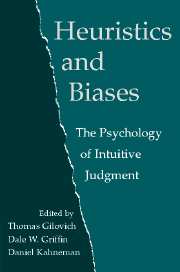Book contents
- Frontmatter
- Contents
- List of Contributors
- Preface
- Introduction – Heuristics and Biases: Then and Now
- PART ONE THEORETICAL AND EMPIRICAL EXTENSIONS
- PART TWO NEW THEORETICAL DIRECTIONS
- PART THREE REAL-WORLD APPLICATIONS
- 33 The Hot Hand in Basketball: On the Misperception of Random Sequences
- 34 Like Goes with Like: The Role of Representativeness in Erroneous and Pseudo-Scientific Beliefs
- 35 When Less Is More: Counterfactual Thinking and Satisfaction among Olympic Medalists
- 36 Understanding Misunderstanding: Social Psychological Perspectives
- 37 Assessing Uncertainty in Physical Constants
- 38 Do Analysts Overreact?
- 39 The Calibration of Expert Judgment: Heuristics and Biases Beyond the Laboratory
- 40 Clinical versus Actuarial Judgment
- 41 Heuristics and Biases in Application
- 42 Theory-Driven Reasoning about Plausible Pasts and Probable Futures in World Politics
- References
- Index
41 - Heuristics and Biases in Application
from PART THREE - REAL-WORLD APPLICATIONS
Published online by Cambridge University Press: 05 June 2012
- Frontmatter
- Contents
- List of Contributors
- Preface
- Introduction – Heuristics and Biases: Then and Now
- PART ONE THEORETICAL AND EMPIRICAL EXTENSIONS
- PART TWO NEW THEORETICAL DIRECTIONS
- PART THREE REAL-WORLD APPLICATIONS
- 33 The Hot Hand in Basketball: On the Misperception of Random Sequences
- 34 Like Goes with Like: The Role of Representativeness in Erroneous and Pseudo-Scientific Beliefs
- 35 When Less Is More: Counterfactual Thinking and Satisfaction among Olympic Medalists
- 36 Understanding Misunderstanding: Social Psychological Perspectives
- 37 Assessing Uncertainty in Physical Constants
- 38 Do Analysts Overreact?
- 39 The Calibration of Expert Judgment: Heuristics and Biases Beyond the Laboratory
- 40 Clinical versus Actuarial Judgment
- 41 Heuristics and Biases in Application
- 42 Theory-Driven Reasoning about Plausible Pasts and Probable Futures in World Politics
- References
- Index
Summary
Heuristics and biases are in the public domain. They appear in texts, courses, books, and applications of many kinds. These endorsements speak to the persuasiveness of the basic research, the severity of the applied problems, and the face validity of debiasing as a possible solution. However, as the research itself shows, popularity alone proves little. Erroneous beliefs can be firmly and widely held even in applied fields with high stakes (Bunker, Barnes, & Mosteller, 1977; Byrne, 1986, Gilovich, 1991). One cannot expect practitioners to read the research literature. Moreover even peer-reviewed journals can be penetrated by vigorous advocates of flawed work. Nor can one expect them to extract simple lessons from individual applications. Coincidental events are always at play, in explanation, prediction, or prescription. Both radical skeptics and rabid enthusiasts can find ad hoc reasons for creating the picture that they seek regarding the applicability of research.
Achieving cumulative wisdom regarding the generalizability of heuristicsand-biases research requires interpreting the available evidence within a stable, comprehensive framework – one that identifies a set of potentially relevant contextual factors and provides bridging theories for characterizing actual situations in its terms. When those situations are in the lab, such a framework might reveal otherwise neglected complexity (when investigators manipulate one feature, without considering concurrent changes in others or the restricted circumstances in which their focal change is possible). With real-world situations, an interpretative framework might reduce otherwise bewildering complexity, by focusing attention on features whose influence (if any) will emerge over time.
- Type
- Chapter
- Information
- Heuristics and BiasesThe Psychology of Intuitive Judgment, pp. 730 - 748Publisher: Cambridge University PressPrint publication year: 2002
- 22
- Cited by



